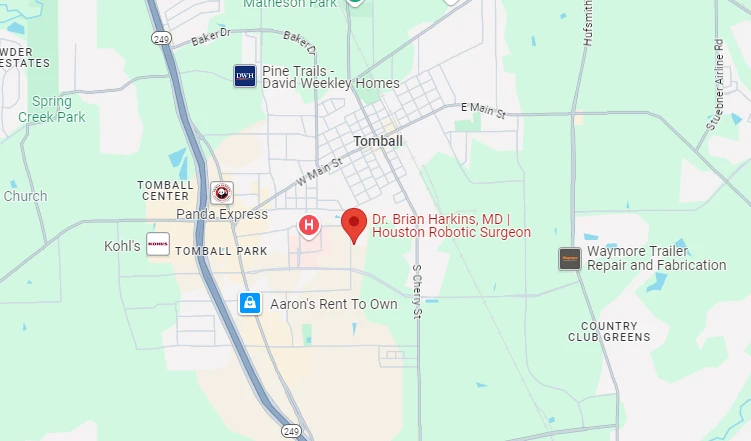
In the Greater Houston Area, robotic surgery has become the go-to minimally invasive approach for complex procedures that once required large incisions. The most frequently performed robotic-assisted surgery to treat urologic cancer is the robot-assisted radical prostatectomy. Understanding why this type of surgery tops local volumes—and which other operations follow close behind—will help you choose the right surgeon, surgical system, and hospital.
Robotic-assisted and laparoscopic surgery aren’t science fiction here—they’re daily realities across Houston’s academic and community hospitals. Multiple da Vinci Xi, X, and single-port consoles allow surgeons to perform a variety of minimally invasive laparoscopic operations with accuracy once impossible through open procedures. Because robotic surgery provides unparalleled visualization and dexterity, surgeons use it for complex cases in urology, colorectal, gynecology, and general surgery.
| Common Robotic Procedure | Estimated Annual Cases (Greater Houston) | Typical Hospital Stay | Primary Specialties |
| Radical prostatectomy | 2,800–3,200 | Same-day or 1 night | Urology, Oncology |
| Total hysterectomy | 1,900–2,100 | 1–2 nights | Gynecology |
| Colorectal resection | 1,400–1,600 | 2–3 nights | Colorectal Surgery |
| Inguinal/Ventral hernia repair | 1,200–1,500 | Outpatient or 1 night | General Surgery |
| Partial nephrectomy | 600–800 | 1–2 nights | Urology |
During robotic-assisted surgical procedures, the surgeon sits at a console that delivers a high-definition view of the surgical site magnified up to ten times. Through small incisions, robotic arms equipped with articulated instruments mimic, filter, and scale the surgeon’s hand movements. This advanced robotic platform allows our surgeons to perform delicate dissections in tight spaces such as the pelvis while protecting nerves and vessels.
High cancer volumes, strong academic programs, and a competitive healthcare market made Houston an early adopter of robot-assisted surgery. Flagship institutions—MD Anderson, Houston Methodist, and Baylor St. Luke’s—trained dozens of specialists who introduced robotic and laparoscopic techniques to community hospitals, expanding access across the region.
The clear volume leader in robotic surgery to treat local prostate cancer is the radical prostatectomy performed with the da Vinci robotic surgery system. Urologists favor this type of minimally invasive approach because it offers oncologic control comparable to open surgical techniques while reducing blood loss and recovery time.
You may be a strong candidate for robotic surgery if you have stage T1–T2 prostate cancer, good overall health, and limited abdominal scarring. Patients with metastases may need other treatment modalities such as radiation.
For large fibroid uteri, endometriosis, or early-stage cancer, robotic-assisted hysterectomy lets gynecologic surgeons work deep in the pelvis through tiny incisions. The approach typically offers shorter hospital stays and quicker return to normal activity than traditional surgery.
Robotic and laparoscopic colorectal surgery improves pelvic access for rectal cancer or diverticulitis. Robotic equipment provides better visualization, helping surgeons avoid a temporary stoma and reduce complications.
In inguinal and ventral hernia cases, robotic technology enables tension-free mesh placement and precise suturing. Many patients walk out the same day, experiencing less pain and a faster recovery.
When kidney tumors require removal, a minimally invasive robotic partial nephrectomy preserves healthy tissue and renal function. Warm ischemia times remain low, and most patients go home within two days.
Always ask:
Look for a hospital with dedicated robotic suites, enhanced-recovery pathways, and 24/7 critical-care coverage. These features show that the facility is serious about advances in robotic care.
Top programs offer pre-operative “robot classes” where you can handle robotic instruments, watch animated videos, and meet nurse navigators. This extra education provides patients with clear expectations and confidence.
After anesthesia review, you’ll receive IV antibiotics. In the operating room, the robotic system is docked once you’re asleep. Most operations last two to four hours, depending on complexity.
Robot-assisted radical prostatectomy remains Houston’s most common robotic procedure, but hysterectomies, colorectal resections, hernia repairs, and kidney surgeries also benefit from this less invasive approach. When performed by experienced surgeons using the latest robotic surgical system, this type of surgery is best for selected candidates who want faster recovery, less pain, and minimal scarring.
Your next step? Schedule a consultation with a high-volume Houston urology or colorectal specialist, bring a notepad, and ask the questions outlined above. The more you know, the smoother your journey from diagnosis to full recovery will be.
Studies show that robotic-assisted surgery results in lower blood loss, fewer transfusions, and reduced infection rates compared to open surgical techniques. However, safety still depends on the complexity of the case, the surgeon’s experience, and the hospital’s protocols.
Both approaches use small incisions, but robotic surgery’s wristed instruments often lead to gentler tissue handling. Many patients report returning to work and daily activities three to five days sooner with robotic operations than with standard laparoscopy.
Single-port technology allows one small incision, providing a virtually scar-less outcome. Availability depends on your hospital and your surgeon’s training; ask during your consultation to determine if you’re a candidate.
Robotic platforms excel in inguinal, ventral, and incisional hernia repairs, particularly when large defects or prior mesh complicate the anatomy. The enhanced 3-D visualization helps surgeons dissect scar tissue safely.
Hospital charges may be slightly higher due to the robotic equipment, but most insurers reimburse at the same rate for minimally invasive surgery. Shorter hospital stays and fewer complications can offset initial costs.
No. You’ll be under general anesthesia throughout the procedure. The robot’s movements are controlled entirely by your surgeon and are incredibly precise, minimizing trauma to surrounding tissues.
Ask directly for annual and lifetime numbers. Many reputable surgeons publish their volumes on hospital websites or academic profiles. A higher case volume often correlates with better outcomes and fewer complications.
Robotic instruments undergo rigorous cleaning and sterilization cycles following FDA guidelines. Most systems also use disposable sterile drapes on the robotic arms to maintain a contamination-free field.
Robotic systems have multiple redundancies. If a malfunction occurs, the surgeon can quickly convert to standard laparoscopic or open surgery. Such events are extremely rare thanks to robust maintenance schedules.
While most robotic cases are elective, some emergency colorectal and urology surgeries can be performed robotically if the team and equipment are available. The decision depends on patient stability and time sensitivity.


Dr. Brian Harkins is a renowned surgeon specializing in advanced, minimally invasive, and robotic surgical techniques. With a dedication to innovation and personalized patient care, he has transformed countless lives by delivering exceptional outcomes.

I want a website like this, where do i start?